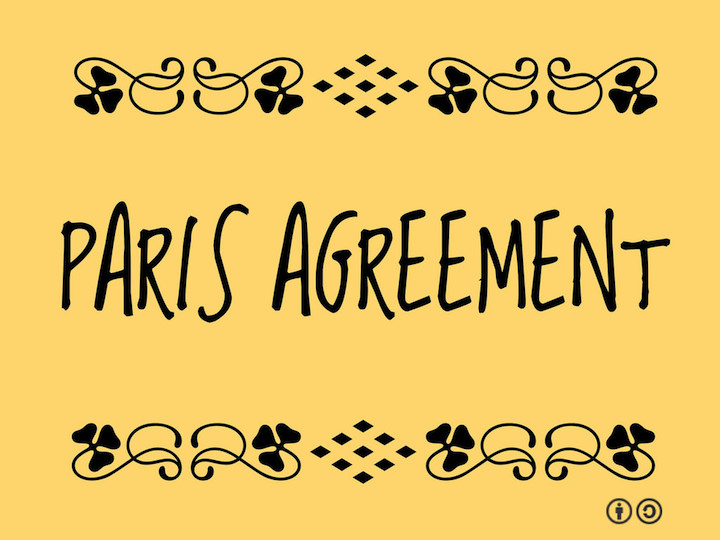
By now, you’ve probably heard that President Trump earlier this month announced that he would be pulling the United States out of the historic Paris Agreement on climate change. While this is troubling to all who particularly enjoy living on a habitable planet, there’s still plenty of questions that remain.
Climate change isn’t some distant threat; it’s already having observable effects on the environment, as confirmed by NASA scientists. We’re seeing the loss of sea ice, accelerated sea level rise and longer, more intense heat waves. Acting on climate isn’t about politics, but doing what’s right for all people living on this planet.
Here’s everything you need to know about how we can still push forward on climate despite the Paris pull-out:
What is the Paris Agreement, exactly?
In December 2015, 195 countries gathered in Paris, France to conclude the first truly universal climate treaty, the Paris Agreement, aimed at preventing the worst-case scenarios of global warming. By signing on to the Agreement, nations agreed to hold global warming to “well below” two degrees Celsius (3.6 degrees Fahrenheit) over pre-Industrial Revolution levels, and to strive for a limit of 1.5 degrees Celsius.
The signatories will aim for emissions to peak “as soon as possible,” with “rapid reductions” thereafter. By the second half of this century, according to the Agreement, there must be a balance between emissions from human activities such as energy production and farming and the amount that can be absorbed by carbon-absorbing “sinks” such as forests or storage technology.
Because developed countries like the U.S. have contributed the most to carbon pollution historically, they must take the lead with absolute emissions cuts. Developing nations, which still burn coal and oil to power growing populations and economies, are encouraged to “continue enhancing” their efforts and “move over time” towards absolute cuts.
The Agreement also requires steady tracking of progress. Beginning in 2018 and every five years thereafter, countries will take stock of the overall impact of their efforts to rein in global warming, according to the text. It “urges” and “requests” countries to update their pledges by 2020. Some countries, including the United States, set emissions-curbing targets for 2025, others for 2030.
Financing was another major component of the Agreement, with rich countries being expected to provide funding to help developing countries make the costly shift to cleaner energy sources and to shore up defenses against the impacts of climate change.
What did the business community think about the Agreement?
Despite the lingering narrative that taking action to fight climate change would hurt the economy, most of the world’s biggest companies have recognized climate change as a business risk and support the Paris Agreement and other actions to mitigate global warming. Since November 2016, some 1,000 companies and investors and investors have signed the Business Backs Low-Carbon USA statement, which reaffirms a deep commitment to addressing climate change through the implementation of the Paris Agreement.
The statement reads:
“We want the US economy to be energy efficient and powered by low-carbon energy. Cost-effective and innovative solutions can help us achieve these objectives. Failure to build a low-carbon economy puts American prosperity at risk. But the right action now will create jobs and boost US competitiveness. We pledge to do our part, in our own operations and beyond, to realize the Paris Agreement’s commitment of a global economy that limits global temperature rise to well below 2 degrees Celsius.”
And this is no rabble of random — Starbucks, General Mills, Dannon, Genentech are among some of the major companies to sign on.
What will happen now that the U.S. is pulling out?
The world is going to continue moving forward on climate action despite the U.S. pullout, although it might be more difficult. However, given the provisions of the Agreement, the U.S. might yet remain in depending on how things go in 2020. While the Agreement makes provision for parties to withdraw, notice can be given only three years after its entry into force in 2016. The actual withdrawal would take effect a year later.
Shortly after Trump’s announcement to pull out of Paris, a coalition of business and local government leaders reaffirmed their commitment to the Paris Agreement by forming the We Are Still In movement. This represents 120 million Americans and $6.2 trillion of the U.S. economy — and over 20 of the businesses who signed on are Fortune 500 companies.
How fighting food and beverage waste also fights climate change
It’s going to take a global effort to unleash the innovation needed to keep the planet’s temperatures at levels that allow us to avoid the worst impacts of climate change. But while it’s good to see progress on the renewable energy front, we won’t succeed unless we also address global food waste. With around 1.3 billion tons of food being wasted each year, according to the the UN Food and Agriculture Organization, this spews 3.3 billion tons of carbon dioxide into the atmosphere. And it’s worth nearly $1 trillion at retail prices.
From Silicon Valley tech giants to the U.S. military, businesses and organizations increasingly are recognizing the value of addressing food and beverage waste in their operations. In Silicon Valley, which is famous for supplying free meals to employees, food waste is an ongoing challenge. However, companies such as Google, Facebook and Apple are getting more creative with making sure all of this waste doesn’t end up in the landfill.
And the U.S. military sees improving its resource efficiency with food waste reduction as a key part of its long-term strategy to keep its soldiers safe. For years, it has openly recognized that climate change will increase the likelihood of global conflict. Another is the economic impact — dealing with food and beverage waste is expensive for the military just as it is for businesses.
While those of us who aspire to create a healthy, habitable world for ourselves and future generations may feel discouraged by Trump’s decision, as Paul Hawken writes in his new book Drawdown, there are many ways we can rebalance our carbon footprint for the longer-term good.
What are you going to do to make a difference on climate? Let us know on the Nourished Planet Facebook page!

